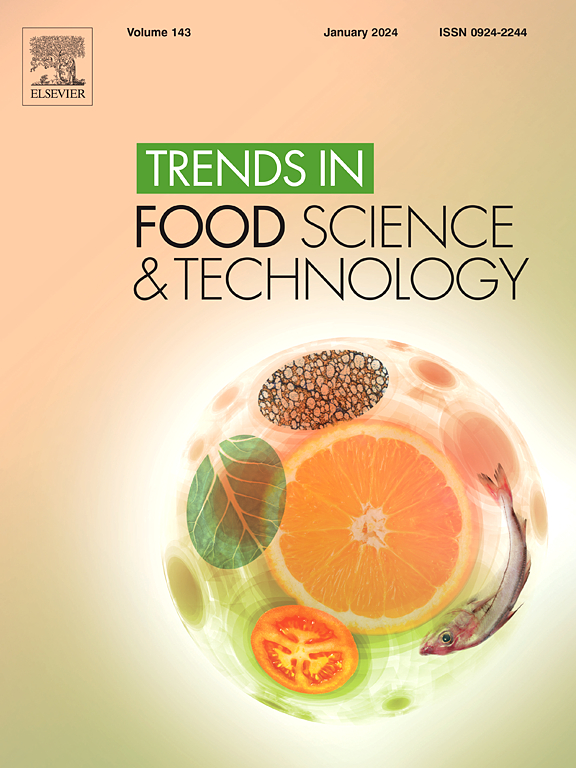食品安全分析的便携式设备和机器学习辅助横向流动分析:发展和前景
IF 15.4
1区 农林科学
Q1 FOOD SCIENCE & TECHNOLOGY
引用次数: 0
摘要
摄入被细菌、化学危害和环境污染物等生物危害污染的食品会造成重大的公共卫生问题。横向流动分析(LFA)技术有助于直观获取定性结果,已被广泛应用,特别是在资源受限的环境中。准确地定量分析物浓度和确保检测结果的可靠性对于即时检测(POCT)应用是非常必要的。因此,迫切需要合适的诊断平台来定量评估LFA的预后。本文对LFA中常用信号的测量原理和发展趋势进行了全面分析。深入讨论了LFA对各种便携、快速、小型化和智能手机集成设备的适应性和优势。此外,还专门探索了机器学习与智能LFA平台设备的集成,以提高食品安全管理理论框架的智能性和效率。除了强调智能平台辅助LFA在食品安全监测中的优势外,我们还对该领域当前面临的挑战和未来方向进行了批判性分析。该智能平台与机器学习辅助LFA相结合,可有效提高LFA的检测灵敏度和稳定性,实现对食源性危害的快速、定量、灵敏检测,解决食品安全快速监测及其实际应用中的重大挑战。预计这项技术将继续发展,并成为应对食品安全问题的全球倡议的重要工具。本文章由计算机程序翻译,如有差异,请以英文原文为准。

Portable devices and machine learning-assisted lateral flow assay for food safety analysis: Developments and perspectives
Background
The ingestion of food contaminated with biological hazards like bacteria, chemical hazards and environmental pollutants can cause major public health issues. The lateral flow assay (LFA) technology facilitates the visual acquisition of qualitative results and has been extensively utilized, especially in resource-constrained settings. It is imperative to accurately quantify analyte concentrations and ensure the reliability of test results for point-of-care testing (POCT) applications. Therefore, there is a pressing requirement for suitable diagnostic platform that can quantitatively evaluate LFA outcomes.
Scope and approach
This review provides a comprehensive analysis of measurement principles and development trends of common signals in LFA. It offers an in-depth discussion on the adaptability and advantages of LFA to various portable, rapid, miniaturized, and smartphone-integrated devices. Furthermore, the integration of machine learning with intelligent LFA platform devices has been specifically explored to enhance intelligence and efficiency of the theoretical framework for food safety management. In addition to emphasizing the benefits of intelligent platform-assisted LFA in food safety monitoring, we also provide a critical analysis of the current challenges and future directions in this field.
Key findings and conclusions
The intelligent platform, integrated with machine learning-assisted LFA, can effectively enhance the detection sensitivity and stability of LFA, enabling rapid, quantitative and sensitive detection of foodborne hazards, addressing significant challenges in rapid food safety monitoring and its practical applications. It is expected that this technology will continue to evolve and become an essential instrument in the global initiative to combat food safety concerns.
求助全文
通过发布文献求助,成功后即可免费获取论文全文。
去求助
来源期刊

Trends in Food Science & Technology
工程技术-食品科技
CiteScore
32.50
自引率
2.60%
发文量
322
审稿时长
37 days
期刊介绍:
Trends in Food Science & Technology is a prestigious international journal that specializes in peer-reviewed articles covering the latest advancements in technology, food science, and human nutrition. It serves as a bridge between specialized primary journals and general trade magazines, providing readable and scientifically rigorous reviews and commentaries on current research developments and their potential applications in the food industry.
Unlike traditional journals, Trends in Food Science & Technology does not publish original research papers. Instead, it focuses on critical and comprehensive reviews to offer valuable insights for professionals in the field. By bringing together cutting-edge research and industry applications, this journal plays a vital role in disseminating knowledge and facilitating advancements in the food science and technology sector.
 求助内容:
求助内容: 应助结果提醒方式:
应助结果提醒方式:


